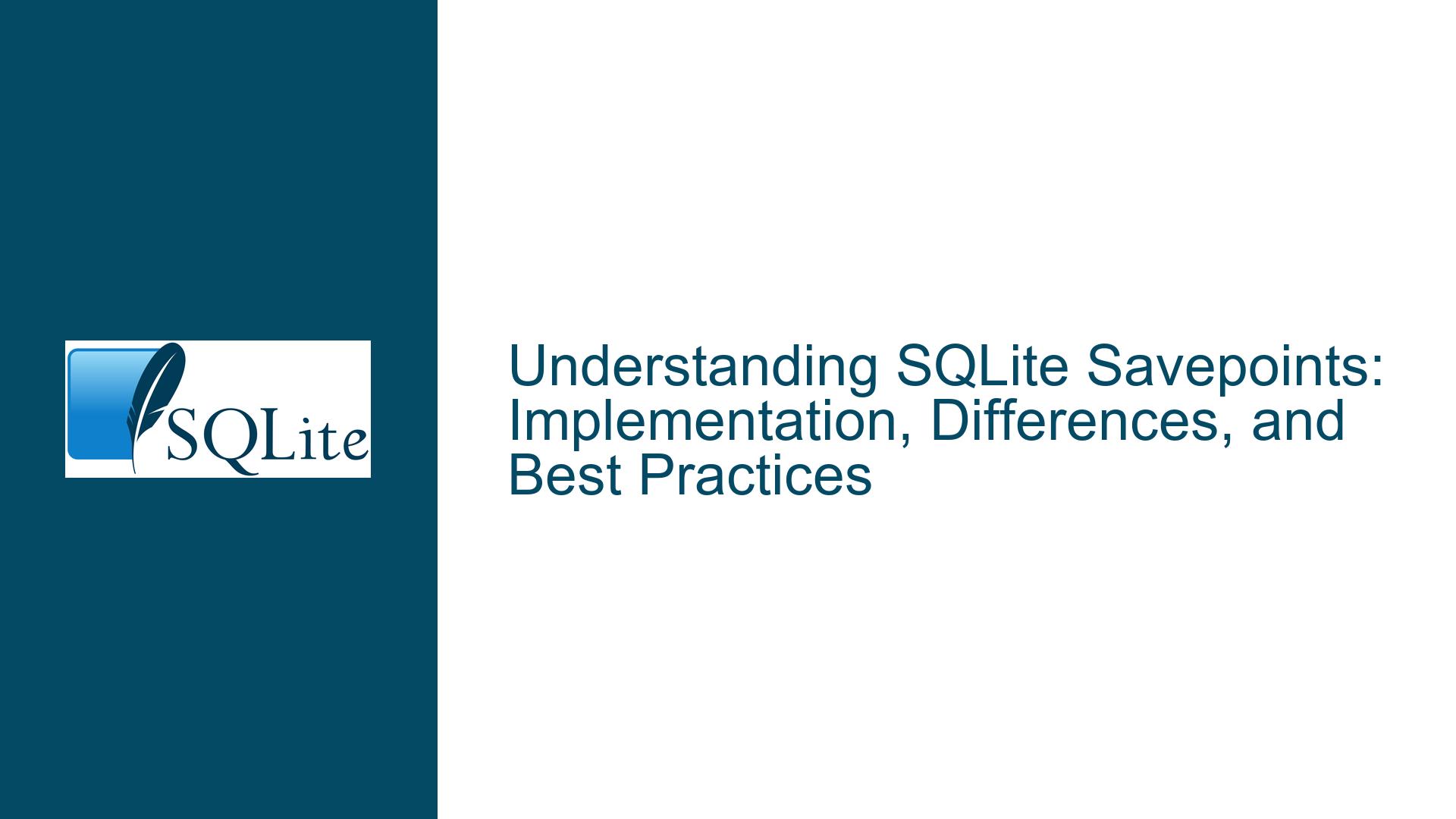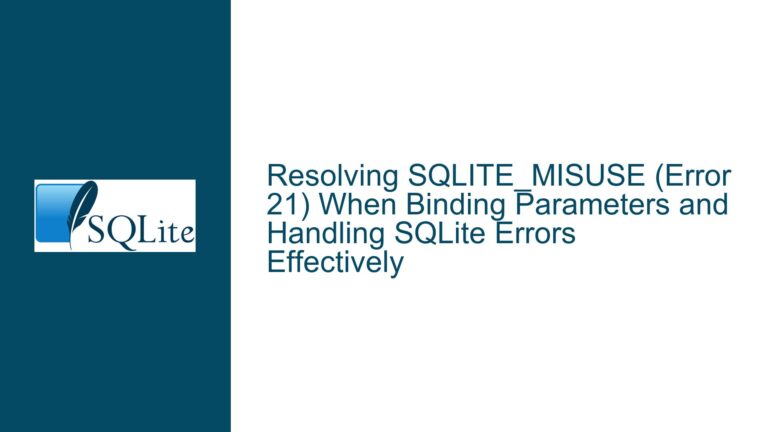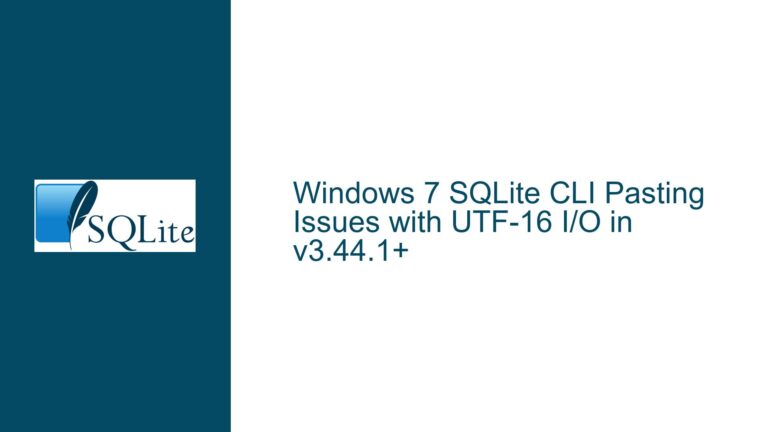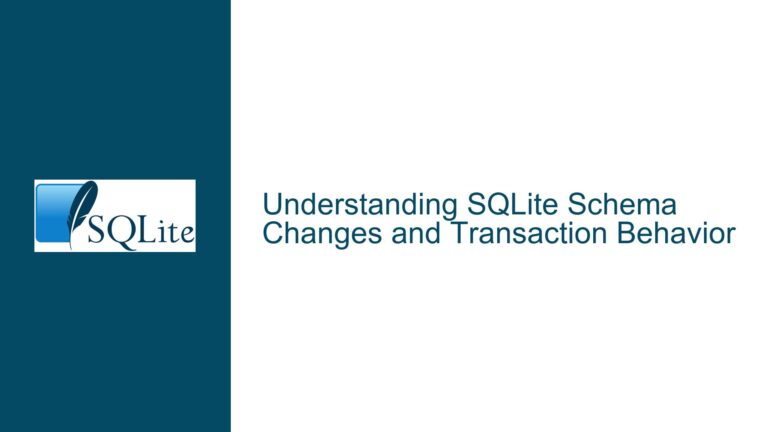SQLite Savepoints: Implementation, Differences, and Best Practices
SQLite Savepoints: A Superset of Standard SQL Transactions
SQLite’s implementation of savepoints is a unique and powerful extension of the SQL standard. Unlike other databases that strictly adhere to the SQL standard’s definition of savepoints as named sub-transactions, SQLite treats savepoints as a superset of both standard transactions and savepoints. This means that in SQLite, a BEGIN/COMMIT transaction is essentially a special case of a savepoint—specifically, an unnamed savepoint. Conversely, a named savepoint outside of a BEGIN/COMMIT block implicitly starts a transaction. This design choice allows SQLite to offer more flexibility and consistency in transaction management.
In SQLite, savepoints are most commonly used as sub-transactions, allowing developers to create nested transactions within a larger transaction. This is particularly useful for complex operations where partial rollbacks might be necessary. The SQLite documentation succinctly captures this by stating that "SAVEPOINTs are a method of creating transactions, similar to BEGIN and COMMIT, except that the SAVEPOINT and RELEASE commands are named and may be nested."
Other databases, such as MariaDB, PostgreSQL, Microsoft SQL Server, and Oracle, adhere more strictly to the SQL standard. For example, MariaDB will silently ignore a savepoint command issued outside of a BEGIN/COMMIT block, whereas SQLite will implicitly start a transaction. This difference in behavior is subtle but significant, as it allows SQLite developers to use savepoints more flexibly without worrying about the context in which they are used.
Internal Implementation of Savepoints in SQLite
The internal implementation of savepoints in SQLite is spread across several key components of the SQLite codebase, primarily vdbe.c, btree.c, and pager.c. Each of these components plays a crucial role in managing savepoints, from assigning sequence numbers to handling the actual rollback operations.
vdbe.c: Managing Savepoint Names and Sequence Numbers
In vdbe.c, the OP_Savepoint opcode is responsible for handling savepoint logic. This opcode calls sqlite3BtreeSavepoint() in btree.c to perform the necessary operations. vdbe.c is also responsible for assigning each savepoint a unique sequence number, which is used internally to manage the nesting of savepoints. This sequence number is crucial for ensuring that rollbacks are performed correctly, especially in nested transactions.
btree.c: Bridging Savepoints and Transactions
The btree.c file implements the sqlite3BtreeSavepoint() function, which in turn calls sqlite3PagerOpenSavepoint() in pager.c. While btree.c does not contain much savepoint-specific logic, it is responsible for managing transactions and sub-transactions. Sub-transactions in SQLite are mapped onto sub-journals, although btree.c itself is not aware of these sub-journals. Instead, it relies on pager.c to handle the details of sub-journal management.
pager.c: The Core of Savepoint Logic
The majority of savepoint logic is implemented in pager.c, which maintains an array of PagerSavepoint structures. These structures correspond to the savepoints created by the user and are used to manage the state of the database at each savepoint. pager.c is also responsible for managing sub-journals, which are used to track changes made within nested savepoints. When a rollback to a specific savepoint is requested, pager.c handles the actual rollback operation, ensuring that the database is restored to the correct state.
One interesting aspect of the savepoint implementation in pager.c is its interaction with journal states. Whether SQLite is using Write-Ahead Logging (WAL) mode or not, the savepoint logic remains largely the same. This is somewhat surprising, as one might expect WAL mode to introduce significant differences in how savepoints are handled. However, the pagerUseWal() function and the aWalData[] array are rarely used in the context of savepoints, suggesting that the implications of using savepoints in WAL mode are minimal.
The Surprising Flexibility of SQLite Savepoints
One of the most surprising aspects of SQLite’s savepoint implementation is its flexibility. Unlike other databases, SQLite allows developers to use savepoints as a complete replacement for BEGIN/COMMIT transactions. This means that developers can choose to use only savepoints for all their transaction management needs, unless they require the specific behavior offered by BEGIN IMMEDIATE or BEGIN EXCLUSIVE transactions.
This flexibility is particularly useful in scenarios where developers want to name their transactions or create nested transactions without worrying about the context in which they are used. For example, in SQLite, a developer can create a named savepoint outside of a BEGIN/COMMIT block, and SQLite will implicitly start a transaction. This is not possible in other databases, where savepoints must be used within a BEGIN/COMMIT block.
Furthermore, SQLite’s savepoint implementation allows for nested transactions without requiring any changes in syntax depending on the context. This is in contrast to other databases, where nested transactions must be implemented using savepoints within a BEGIN block. In SQLite, developers can use the same syntax for both top-level and nested transactions, making the code more consistent and easier to understand.
Best Practices for Using Savepoints in SQLite
Given the unique features of SQLite’s savepoint implementation, there are several best practices that developers should follow to make the most of this functionality.
Use Savepoints for Complex Transactions
Savepoints are particularly useful in complex transactions where partial rollbacks might be necessary. By using savepoints, developers can create nested transactions that allow them to roll back to a specific point in the transaction without affecting the entire transaction. This can be especially useful in scenarios where multiple operations are performed within a single transaction, and some of these operations might fail.
Avoid Mixing Savepoints and BEGIN/COMMIT Transactions
While SQLite allows developers to mix savepoints and BEGIN/COMMIT transactions, it is generally best to avoid doing so. Instead, developers should choose one approach and stick to it. Using savepoints exclusively for transaction management can make the code more consistent and easier to understand, especially in complex applications where nested transactions are common.
Use Named Savepoints for Better Debugging
Named savepoints can be particularly useful for debugging, as they allow developers to easily identify the point in the transaction where an error occurred. By using descriptive names for savepoints, developers can quickly locate the source of an error and take appropriate action.
Be Aware of the Implications of WAL Mode
While the savepoint implementation in SQLite is largely the same regardless of whether WAL mode is enabled, developers should still be aware of the implications of using savepoints in WAL mode. In particular, developers should ensure that they understand how WAL mode affects transaction management and how it interacts with savepoints.
Regularly Test Savepoint Rollbacks
Given the complexity of nested transactions and savepoints, it is important to regularly test savepoint rollbacks to ensure that they work as expected. This is especially important in scenarios where multiple savepoints are used within a single transaction, as errors in the rollback logic can lead to data corruption or other issues.
Conclusion
SQLite’s implementation of savepoints is a powerful and flexible feature that extends the capabilities of standard SQL transactions. By treating savepoints as a superset of both standard transactions and savepoints, SQLite allows developers to create nested transactions and manage complex operations with ease. The internal implementation of savepoints in SQLite is spread across several key components of the SQLite codebase, each of which plays a crucial role in managing savepoints and ensuring that rollbacks are performed correctly.
Developers who take the time to understand SQLite’s savepoint implementation and follow best practices can leverage this feature to create more robust and maintainable applications. Whether you are working on a simple application or a complex system with nested transactions, SQLite’s savepoints offer a level of flexibility and consistency that is unmatched by other databases.






